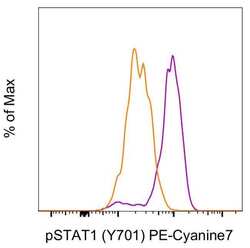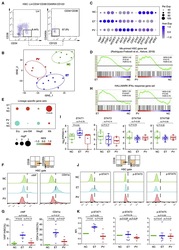Antibody data
- Antibody Data
- Antigen structure
- References [1]
- Comments [0]
- Validations
- Flow cytometry [1]
- Other assay [1]
Submit
Validation data
Reference
Comment
Report error
- Product number
- 25-9008-41 - Provider product page

- Provider
- Invitrogen Antibodies
- Product name
- Phospho-STAT1 (Tyr701) Monoclonal Antibody (KIKSI0803), PE-Cyanine7, eBioscience™
- Antibody type
- Monoclonal
- Antigen
- Other
- Description
- Description: This KIKSI0803 monoclonal antibody recognizes signal transducer and activator of transcription 1 (STAT1) when phosphorylated on tyrosine 701. STAT proteins are activated by ligand binding to receptors, such as cytokine receptors, that associate with Janus kinase (JAK) family members. Following their phosphorylation by JAKs, STAT proteins translocate to the nucleus where they bind to DNA and regulate transcription of specific genes in a cell type- and cytokine-specific manner. Phosphorylation of STAT1 on tyrosine 701 by JAK1 and JAK2 is essential for STAT1 dimer formation, nuclear translocation, and DNA binding activity. In response to IFN gamma stimulation, STAT1 homodimerizes or forms heterodimers with STAT3 that can bind to GAS (IFN gamma-activated sequence) promoter elements. In response to either IFN alpha or IFN beta stimulation, STAT1 forms a heterodimer with STAT2 that can bind ISRE (IFN-stimulated response element) promoter elements. Specificity of this KIKSI0803 clone was determined by ELISA, flow cytometry, and western blotting. Applications Reported: This KIKSI0803 antibody has been reported for use in intracellular staining followed by flow cytometric analysis. Applications Tested: This KIKSI0803 antibody has been pre-diluted and tested by intracellular staining followed by flow cytometric analysis of stimulated normal human peripheral blood cells using Protocol C: Two-step protocol for Fixation/Methanol. Protocol A: Two-step protocol for intracellular (cytoplasmic) proteins and Protocol B: One-step protocol for intracellular (nuclear) proteins cannot be used. All Protocols can be found in “Staining Intracellular Antigens for Flow Cytometry" located at www.thermofisher.com/flowprotocols . This may be used at 5 µL (0.125 µg) per test. A test is defined as the amount (µg) of antibody that will stain a cell sample in a final volume of 100 µL. Cell number should be determined empirically but can range from 10^5 to 10^8 cells/test. Light sensitivity: This tandem dye is sensitive to photo-induced oxidation. Please protect this vial and stained samples from light. Fixation: Samples can be stored in IC Fixation Buffer (Product # 00-8222-49) (100 µL of cell sample + 100 µL of IC Fixation Buffer) or 1-step Fix/Lyse Solution (Product # 00-5333-57) for up to 3 days in the dark at 4°C with minimal impact on brightness and FRET efficiency/compensation. Some generalizations regarding fluorophore performance after fixation can be made, but clone specific performance should be determined empirically. Excitation: 488-561 nm; Emission: 775 nm; Laser: Blue Laser, Green Laser, Yellow-Green Laser.
- Reactivity
- Human
- Host
- Mouse
- Isotype
- IgG
- Antibody clone number
- KIKSI0803
- Vial size
- 25 Tests
- Concentration
- 5 µL/Test
- Storage
- 4°C, store in dark, DO NOT FREEZE!
Submitted references Hematopoietic stem cell heterogeneity is linked to the initiation and therapeutic response of myeloproliferative neoplasms.
Tong J, Sun T, Ma S, Zhao Y, Ju M, Gao Y, Zhu P, Tan P, Fu R, Zhang A, Wang D, Wang D, Xiao Z, Zhou J, Yang R, Loughran SJ, Li J, Green AR, Bresnick EH, Wang D, Cheng T, Zhang L, Shi L
Cell stem cell 2021 Apr 1;28(4):780
Cell stem cell 2021 Apr 1;28(4):780
No comments: Submit comment
Supportive validation
- Submitted by
- Invitrogen Antibodies (provider)
- Main image

- Experimental details
- Normal human peripheral blood cells were unstimulated (orange histogram) or stimulated for 15 minutes with Human IFN gamma Recombinant Protein (Product # BMS303) (purple histogram). Cells were then stained intracellularly, using the IC Fixation Buffer (Product # 00-8222-49) and Fixation/Methanol protocol, with Phospho-STAT1 (Tyr701) Monoclonal Antibody, PE-Cyanine7. CD14+ CD4-low cells in the monocyte gate were used for analysis.
Supportive validation
- Submitted by
- Invitrogen Antibodies (provider)
- Main image

- Experimental details
- Figure 1 ET HSCs Exhibit Prominent Mk Lineage Priming and Elevated Interferon (IFN) Signaling (A) Representative flow cytometry profiles for HSC isolation from bone marrow mononuclear cells (BM-MNCs) ( Table S1 ). (B) t-SNE analysis of transcriptomic profiles of HSCs from individuals with JAK2V617F + ET and PV and normal controls (NCs). (C) Selected feature genes from ET, PV, and NC HSCs. The percentage of expressing samples (Per.Exp) and average expression values (Aver.Exp) are shown. (D) GSEA of Mk-primed HSC gene sets in HSCs of affected individuals and NCs ( Table S2 ). Normalized enrichment score (NES), p value, and false discovery rate (FDR) are shown. (E) GSEA of various lineage-restricted or primed gene sets in pre-granulocytes and monocytes (pre-GMs), Mk and erythroid precursors (MegEs), and erythroid precursors (Erys) ( Table S2 ). (F) Strategy and representative flow cytometry of vWF + and CD41a + HSC subpopulations. (G) Proportions of vWF + and CD41a + HSC subpopulations shown in (F). (H) GSEA of the HALLMARK IFNalpha response gene set in HSCs of affected individuals and NCs. (I) STAT gene expression in ET, PV, and NC HSCs. Log 2 -transformed (fragments per kilobase million [FPKM]+1) are shown for individuals. Thick horizontal lines indicate median expression levels, and boxes represent the first and third quartiles. (J) Strategy and representative flow cytometry for measurement of phosphorylated STAT1 (p-STAT1), p-STAT3, and p-STAT5 levels. (K) Relative fluoresce
 Explore
Explore Validate
Validate Learn
Learn Flow cytometry
Flow cytometry